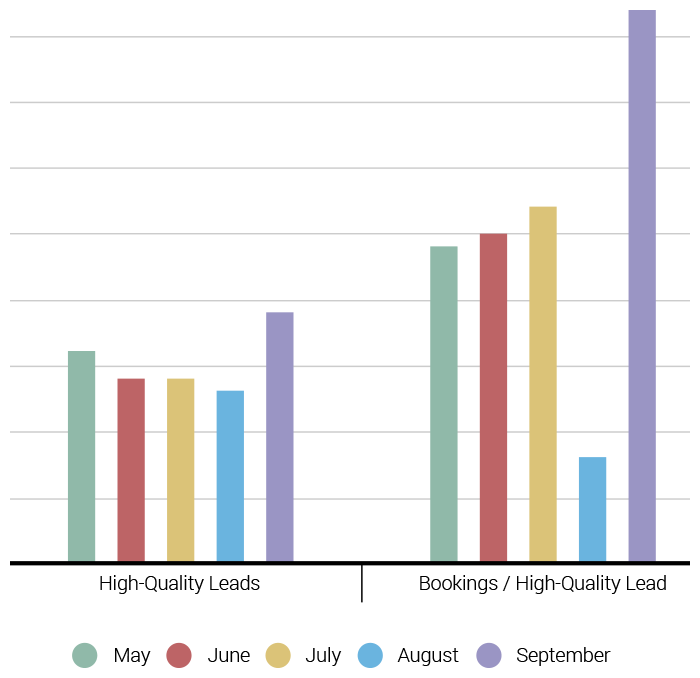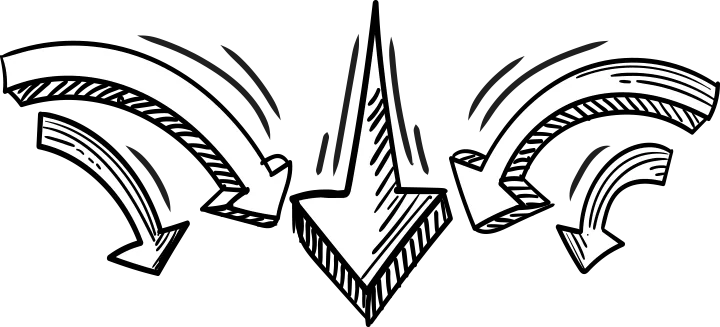I hate conversion rate. OK, hate is a bit strong. But I’m tired of how haphazardly it’s thrown around in marketing meetings. It’s typically a misguided security blanket or an unwarranted fire alarm. Rarely is it used as the insightful yardstick it was intended. To begin our dive let’s take a look at what it is. By the most basic of definition conversion rate is the percentage of website visitors who take a desired action. But there are a variety of ways this can go astray. Here are how two very different examples produce the same exact conversion rate.
Company A aggressively advertises to reach pretty much everyone in the country. Even your grandma knows about their technology from their incessant advertising campaigns. But their in-house optimization team is amazing. They test and re-work landing pages, calls-to-actions, and are doing everything possible to convert this mountain of traffic.
5,000 desired actions / 500,000 unique visitors / month = 1% conversion rate
Company B is conservative and intentional with their advertising campaign. They target to a fault attempting to market only to their ideal customers. But they don’t have the in-house resources to do testing of any kind and have a few landing pages they haven’t analyzed in years.
100 desired actions / 10,000 unique visitors / month = 1% conversion rate
Both have a 1% conversion rate and as a stand-alone KPI it’s meaningless. We need to dig deeper. Unless real-world, business-savvy, “let’s-get-fo-real” questions are asked, it just paints a simplistic view of the world. And worse, it’s not insightful. Life is complicated. It’s messy – both as marketers and as consumers. Seemingly well-researched ad campaigns miss the mark all the time. Innocuous fantasy football apps send out notifications about Rob Gronkowski’s last touchdown interrupts my hotel reservation attempt. And it times out. No booked hotel room for me. This type of scenario plays out millions of ways everyday single day. As marketers, we need to put some time, effort, and experience into how we create and understand the subtleties of conversion rate so that we measure what matters. Otherwise it’s just meaningless crap.
Unfortunately, most people view conversion rate like it’s etched in stone. “Well, obviously it’s the number of people who buy our stuff divided by the number of people who visit our website. While technically accurate, it’s hardly insightful. Here are just a handful of scenarios that skew conversion rates for businesses everyday.
- Seasonality
- Viral Content
- Lead Quality Variation
- Elections
- Trends
- Hurricanes
- Vacations
- Financial Markets
- Supply
- Demand
- Children Customer Service
- Competition
- March Madness
- Guns n’ Roses
- Gronk
As marketers we need to measure with the metrics of life in mind. Don’t create conversion rates in the cold vacuum of a lab. The people we’re attempting to reach have families, jobs, aspirations, challenges, and unique perspectives that must be considered for your goals and KPI’s to matter. There are no insights without understanding. Without that, they’re just numbers. Rob Gronkowski has a BMI of 30.6 – By definition he is obese. There’s a metric that doesn’t matter. He’s 6’6” and weighs 265 pounds. That gives him a BMI (body mass index) of 30.6 and defines him as obese. I’m not his personal trainer, but I’m go out on a limb here and say he’s not. Marketers and business owners trust the same kind of same meaningless measurements all the time. The problem is that without deeper context it means nothing. And even worse, it leads to poor decisions – like cutting Gronk because he’s too fat to play in the NFL.
How to Create High-Confidence Conversion Rates
The first step is to understand what’s really driving your business. Be honest. Be truthful to yourself and your marketing team. Car dealerships want to get people on the lot. Universities want prospective students to have a great campus visit. Supermarkets put candy in the checkout aisle. Think about what REALLY drives your business and measure it. Call it a conversion rate. Measure it over time. That’s it. But it has to be something that honestly drives your business.
We work with a business in the ultra-competitive industry of corporate finance. It’s crazy-expensive to advertise to their target audience. Every click counts. Because of that, we don’t track traditional conversion rates for them. We don’t even track leads. We track high-quality leads and the ratio of bookings to high-quality leads – nothing else matters. When we noticed the B / HQL ratio (bookings / high-quality leads) were flat for a few months in a row we took action and performed a user test to discover why. It pushed us to glean some amazing insights on our client’s behalf and helped them improve their business. They need both high-quality leads AND a high percentage of those to qualify for loans.

There are many ways to get started, but here’s a three-step conversion rate quick-start process to create a conversion rate that counts.
- Meet your team and have a VERY honest conversation about why your customers or clients buy from you. I mean why do they REALLY buy from you. What’s in it for them? What do you provide that is unique?
- Figure out how you’d measure that thing you do better than anyone else. Can it be measured in Google Analytics? Do you need call tracking or another form of measurement? Don’t let technology slow you down. Give thought to the best way(s) to track this new conversion rate.
- And finally, start testing these new conversion rates. Which one(s) best reflect your business’ actual performance? Keep the ones that work and drop the ones that don’t. Use surveys to test them. Perform user tests to see if you’re on the mark. Question your assumptions.
Once you have conversion rates you can trust, start leaning on them. You’ll have a finger on the pulse of your business like never before. It’ll allow you to improve your website, double-down on campaigns that are killing it, cut the ones that aren’t and have the confidence and insight to know the difference. Look for our next blog post where we’ll highlight examples of conversion rates that count and show our step-by-step process for creating new ones.


